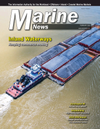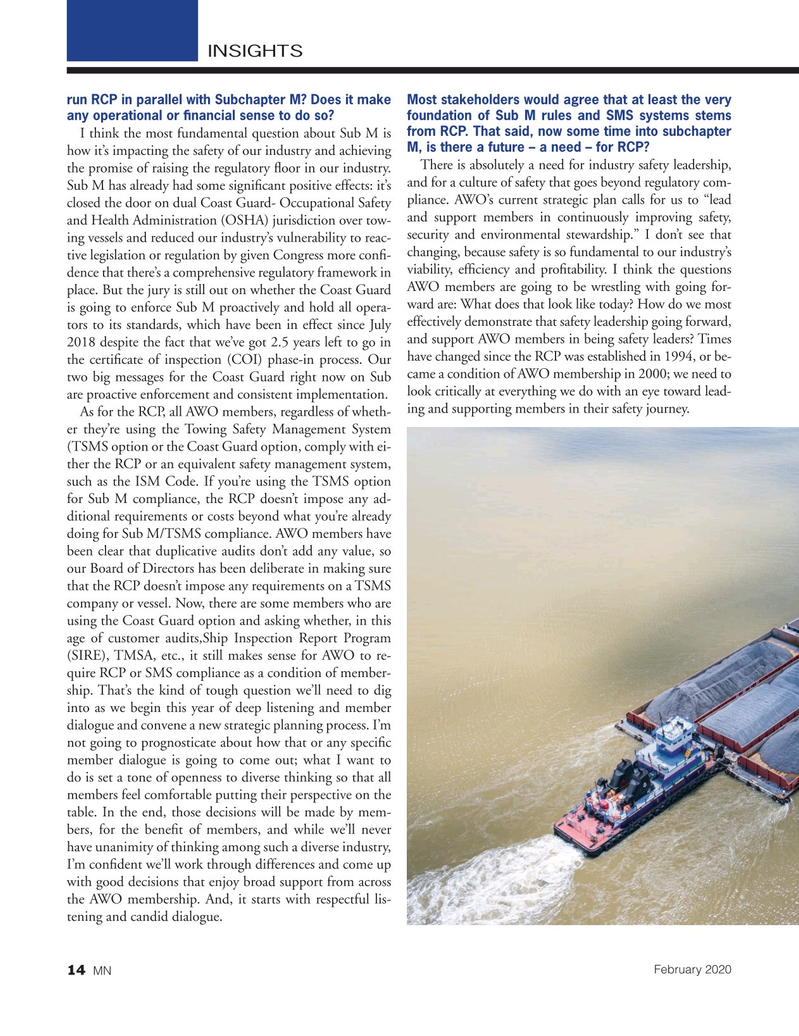
Page 14: of Marine News Magazine (February 2020)
Pushboats,Tugs & Assist Vessels
Read this page in Pdf, Flash or Html5 edition of February 2020 Marine News Magazine
INSIGHTS run RCP in parallel with Subchapter M? Does it make Most stakeholders would agree that at least the very any operational or ? nancial sense to do so? foundation of Sub M rules and SMS systems stems from RCP. That said, now some time into subchapter
I think the most fundamental question about Sub M is
M, is there a future – a need – for RCP? how it’s impacting the safety of our industry and achieving
There is absolutely a need for industry safety leadership, the promise of raising the regulatory ? oor in our industry.
Sub M has already had some signi? cant positive effects: it’s and for a culture of safety that goes beyond regulatory com- closed the door on dual Coast Guard- Occupational Safety pliance. AWO’s current strategic plan calls for us to “lead and support members in continuously improving safety, and Health Administration (OSHA) jurisdiction over tow- security and environmental stewardship.” I don’t see that ing vessels and reduced our industry’s vulnerability to reac- changing, because safety is so fundamental to our industry’s tive legislation or regulation by given Congress more con? - dence that there’s a comprehensive regulatory framework in viability, ef? ciency and pro? tability. I think the questions place. But the jury is still out on whether the Coast Guard AWO members are going to be wrestling with going for- ward are: What does that look like today? How do we most is going to enforce Sub M proactively and hold all opera- tors to its standards, which have been in effect since July effectively demonstrate that safety leadership going forward, 2018 despite the fact that we’ve got 2.5 years left to go in and support AWO members in being safety leaders? Times the certi? cate of inspection (COI) phase-in process. Our have changed since the RCP was established in 1994, or be- two big messages for the Coast Guard right now on Sub came a condition of AWO membership in 2000; we need to look critically at everything we do with an eye toward lead- are proactive enforcement and consistent implementation.
ing and supporting members in their safety journey.
As for the RCP, all AWO members, regardless of wheth- er they’re using the Towing Safety Management System (TSMS option or the Coast Guard option, comply with ei- ther the RCP or an equivalent safety management system, such as the ISM Code. If you’re using the TSMS option for Sub M compliance, the RCP doesn’t impose any ad- ditional requirements or costs beyond what you’re already doing for Sub M/TSMS compliance. AWO members have been clear that duplicative audits don’t add any value, so our Board of Directors has been deliberate in making sure that the RCP doesn’t impose any requirements on a TSMS company or vessel. Now, there are some members who are using the Coast Guard option and asking whether, in this age of customer audits,Ship Inspection Report Program (SIRE), TMSA, etc., it still makes sense for AWO to re- quire RCP or SMS compliance as a condition of member- ship. That’s the kind of tough question we’ll need to dig into as we begin this year of deep listening and member dialogue and convene a new strategic planning process. I’m not going to prognosticate about how that or any speci? c member dialogue is going to come out; what I want to do is set a tone of openness to diverse thinking so that all members feel comfortable putting their perspective on the table. In the end, those decisions will be made by mem- bers, for the bene? t of members, and while we’ll never have unanimity of thinking among such a diverse industry,
I’m con? dent we’ll work through differences and come up with good decisions that enjoy broad support from across the AWO membership. And, it starts with respectful lis- tening and candid dialogue.
February 2020 14 MN

 13
13

 15
15
